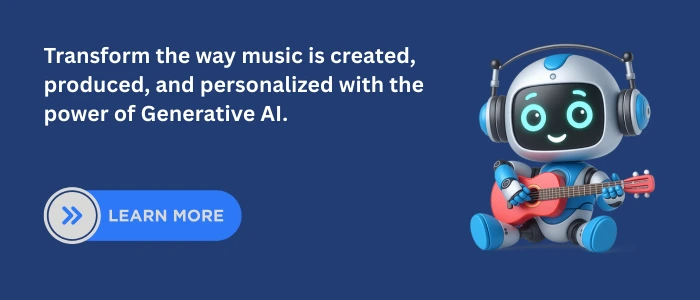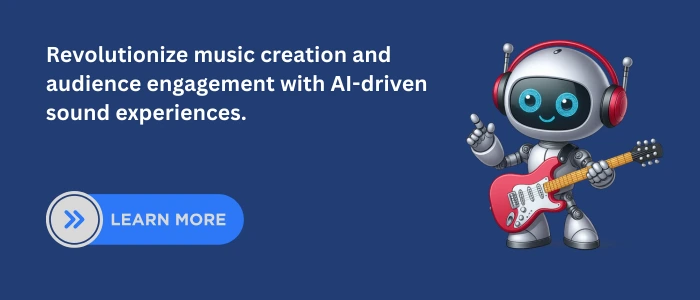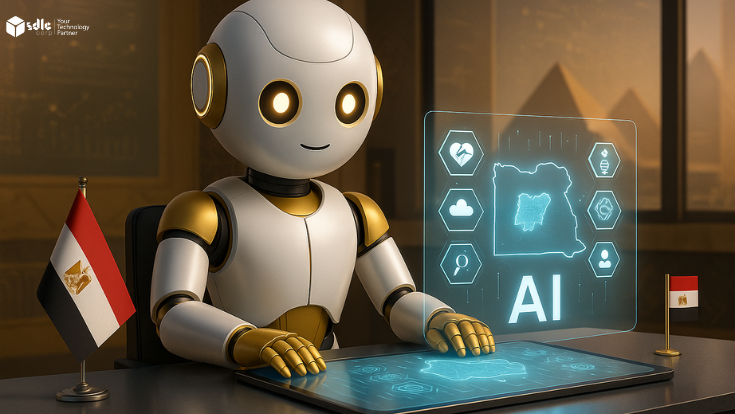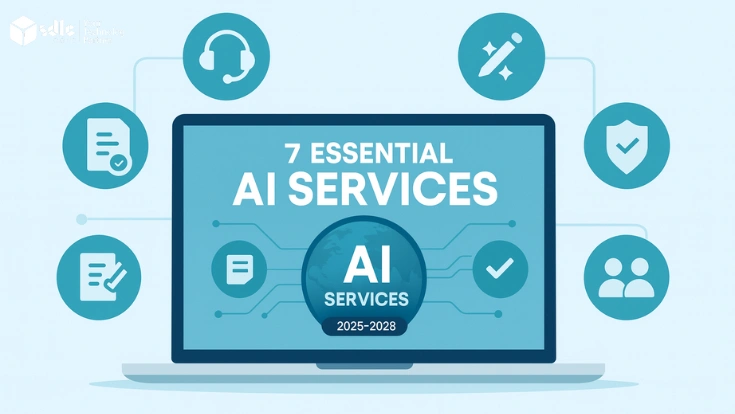Introduction
Generative AI is redefining the music industry, transforming how compositions are created, produced, and personalized. Powered by deep learning, neural networks, and advanced algorithmic composition models, AI-driven platforms enable musicians, producers, and independent creators to generate professional-quality tracks with unprecedented efficiency. The AI music generation market is projected to surpass $3.1 billion by 2028, growing at over 45% annually as adoption expands across studios, streaming platforms, and live performances.
From AI-assisted songwriting, automated mastering, and adaptive soundtracks to personalized music experiences, these innovations are reshaping creativity and monetization strategies. To fully leverage this potential, organizations are partnering with expert AI Development Providers who deliver enterprise-grade solutions that ensure scalability, compliance, and innovation.
1. How Generative AI Transforms Music Creation
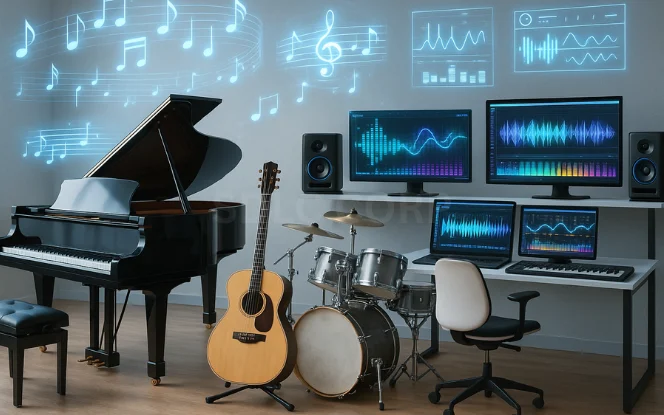
Generative models are increasingly used to assist with melody generation, harmony structuring, and audio experimentation. These systems explore musical patterns while respecting stylistic and structural constraints. Teams building such tools often rely on Generative AI development services to train models on licensed datasets and domain-specific musical features.
AI-Powered Composition Tools
Modern AI composition platforms use deep learning algorithms to replicate and innovate musical creativity across genres.
Core Capabilities Include:
- Melody & Harmony Generation → AI models trained on thousands of compositions can generate harmonically rich sequences that balance coherence and originality. This enables music creation across classical, jazz, pop, EDM, and experimental genres.
- Rhythm & Beat Creation → AI can design dynamic drum patterns and percussion sequences, adapting from simple 4/4 beats to complex polyrhythmic structures found in progressive music.
- Full Song Structuring → Advanced models understand song architecture (verse, chorus, bridge, outro), ensuring emotional flow and narrative continuity in AI-generated tracks.
Automated Music Production
Generative AI is also transforming the production phase, offering capabilities that rival professional studios.
Key Innovations Include:
- AI Mixing & Mastering → Systems analyze audio stems, balance frequency spectrums, apply compression, and enhance stereo imaging with studio-grade precision.
- AI-Powered Sound Design & Synthesis → By leveraging neural audio synthesis, AI creates novel instruments, textures, and timbres beyond traditional acoustic or electronic sources—expanding the creative palette for artists and producers.
2. Leading AI Music Platforms and Tools
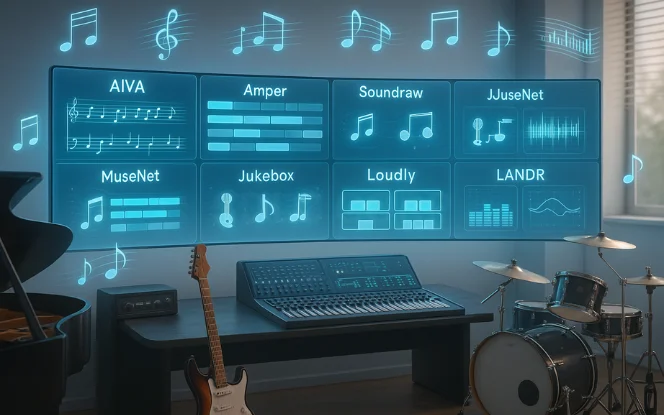
The rise of Generative AI in music production has given creators access to advanced platforms that combine neural networks, deep learning, and algorithmic composition. From professional-grade solutions for composers to consumer-friendly apps for beginners, these tools are reshaping how music is created, produced, and distributed.
Professional-Grade Solutions
- AIVA (Artificial Intelligence Virtual Artist) → Known for its orchestral and cinematic composition capabilities, AIVA leverages AI-driven orchestration models to generate complex arrangements suitable for film scores, video games, and commercial soundtracks.
- Amper Music & Soundraw → Offer intuitive interfaces while maintaining studio-quality output. They are widely used by content creators, advertisers, and independent musicians who need fast, royalty-free compositions.
- OpenAI’s MuseNet & Jukebox → Represent cutting-edge research platforms that demonstrate how AI can learn and replicate diverse musical genres while generating entirely original compositions with multi-instrument harmonics and vocal synthesis.
Consumer-Friendly Applications
- Boomy & Loudly → Democratize music creation by allowing users with no formal training to generate professional-grade tracks in minutes. These apps use simplified AI interfaces supported by complex generative algorithms.
- LANDR → A leader in AI-powered mastering, LANDR has processed millions of tracks using adaptive learning algorithms. The platform applies frequency balancing, compression, and stereo imaging enhancements automatically, ensuring broadcast-ready sound quality.
3. Benefits of Generative AI for Music Professionals
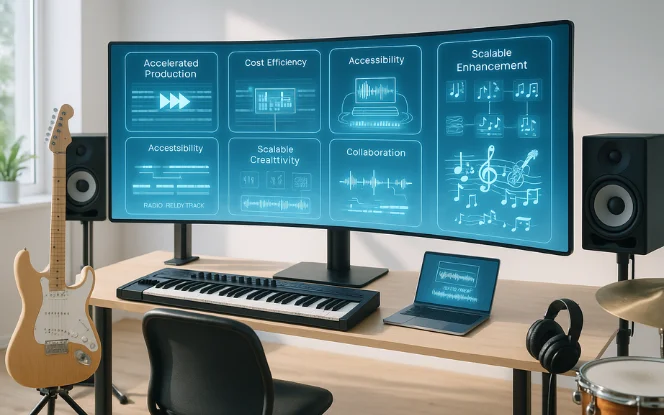
Generative AI is reshaping the way musicians, producers, and composers create, collaborate, and distribute music. By combining deep learning, neural networks, and algorithmic composition, AI tools empower professionals to push creative boundaries while improving efficiency and accessibility.
Enhanced Efficiency and Accessibility
AI music platforms streamline workflows by automating complex production processes and enabling faster iteration.
Key Benefits Include:
- Accelerated production cycles → Artists can experiment with melodies, harmonies, and arrangements without extensive manual programming.
- Cost efficiency → Reduced reliance on traditional studio time lowers production expenses.
- Accessibility for independent creators → Bedroom producers can create radio-ready tracks using standard home equipment with AI mastering and arrangement tools.
- Scalable creativity → Musicians can generate multiple variations of a track, optimizing both output volume and quality.
Creative Enhancement and Collaboration
AI acts as a co-creator, offering musicians new perspectives, stylistic experimentation, and fresh inspiration.
Creative Advantages:
- Overcoming writer’s block with AI-suggested chord progressions, melodic variations, and rhythmic structures
- Genre-blending capabilities → AI models can merge elements of classical, EDM, jazz, or hip-hop to create hybrid styles
- Unconventional approaches → Generative algorithms suggest arrangements that human creators may overlook
- Collaborative synergy → Artists and AI systems co-develop compositions, leading to innovative and unexpected results
4. Industry Applications and Impact of Generative AI in Music
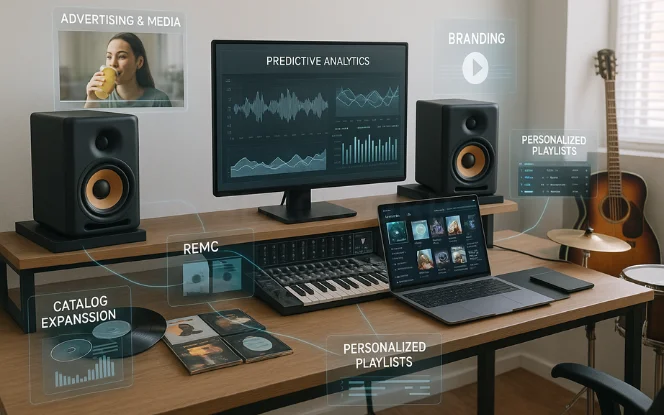
Generative AI is not only transforming music creation but also reshaping the commercial, media, and record label ecosystems. By combining algorithmic composition, predictive analytics, and neural recommendation engines, AI delivers scalable solutions for content personalization, catalog management, and talent discovery.
Commercial and Media Applications
AI-generated music is becoming a cornerstone of the media, advertising, and entertainment industries, offering cost-effective and scalable alternatives to traditional licensing models.
Key Applications Include:
- Background music for advertising & media → Royalty-free, AI-generated tracks tailored to specific moods, themes, or campaigns.
- Custom compositions for branding → AI can adapt music to brand identity, ensuring emotional resonance with audiences.
- Personalized playlist generation → Streaming platforms leverage AI recommendation algorithms to analyze listening patterns, demographics, and behavioral data, creating dynamic and engaging playlists that improve retention.
Record Labels and Publishing
Record labels and publishers are leveraging AI-powered tools to optimize talent scouting, catalog development, and content monetization.
Impact Areas:
- A&R (Artist & Repertoire) Discovery → AI analyzes social media trends, streaming data, and audience engagement metrics to identify emerging artists and potential hit tracks.
- Catalog expansion → AI generates remixes, alternate arrangements, and complementary tracks, allowing publishers to grow their content libraries rapidly.
- Content diversification → Labels can explore new genres and hybrid styles with AI-generated compositions, appealing to wider audiences.
- Data-driven investment decisions → Predictive analytics helps labels allocate resources more effectively toward high-potential artists.
Read Also : Generative AI for the Automotive Industry
5. Challenges and Future Considerations for Generative AI in Music

While Generative AI in the music industry offers groundbreaking opportunities, it also raises significant legal, creative, and adoption-related challenges. Addressing these issues will be essential for sustainable integration of AI-powered music solutions.
Legal and Quality Concerns
Copyright & Intellectual Property
- The ownership of AI-generated compositions remains a legal gray area, with ongoing debates around copyright attribution, licensing rights, and royalties.
- Musicians and producers must carefully navigate intellectual property frameworks to ensure proper attribution and licensing compliance when deploying AI-generated tracks.
Authenticity & Artistic Depth
- Critics argue that AI-generated music may lack emotional resonance, raising concerns about authenticity and artistic integrity.
- Advances in deep learning, expressive modeling, and sentiment-aware algorithms are gradually bridging this gap, enabling AI to capture more human-like musical nuance.
Integration and Adoption Challenges
Industry Resistance
- Traditional musicians and producers often perceive AI as a replacement threat, leading to hesitation in adoption.
- As human-AI co-creation models gain acceptance, resistance is decreasing, with AI being recognized as a creative assistant rather than a substitute.
Successful Adoption Requires:
- Clear role definition of AI as a supportive tool for ideation, production, and workflow efficiency.
- Hybrid creative models where artists leverage AI for inspiration while retaining human oversight for emotional depth and authenticity.
- Education and training for artists, producers, and labels to integrate AI tools seamlessly into existing music production pipelines.
6. Best Practices for Implementing Generative AI in Music
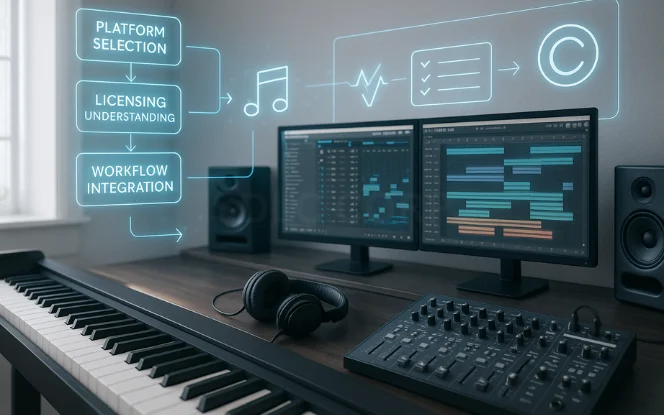
Implementing Generative AI in the music industry requires a balanced strategy that ensures both creative authenticity and technical efficiency. By combining AI-assisted composition tools with human expertise, musicians and producers can maximize innovation while maintaining artistic integrity.
Getting Started Successfully
Musicians and producers should adopt AI tools strategically, ensuring that their use enhances rather than replaces human creativity.
Key Best Practices:
- Select the right platform → Choose AI music platforms that align with your genre, workflow, and licensing requirements.
- Understand licensing terms → Carefully review copyright and royalty agreements for AI-generated content.
- Start with simple projects → Experiment with basic compositions, loops, or background tracks to learn system capabilities.
- Balance AI and human creativity → Use AI for inspiration, idea generation, and foundational structures while applying human judgment for emotional nuance, storytelling, and performance quality.
Workflow Integration
Seamless integration ensures that AI becomes a creative partner rather than a disruption to established processes.
Integration Best Practices:
- Gradual adoption → Introduce AI tools step by step, complementing rather than replacing existing workflows.
- Maintain human oversight → Producers should apply quality control checks to guarantee that AI-generated content supports the artistic vision.
- Hybrid workflows → Combine AI-driven composition, rhythm generation, and automated mastering with human refinement to achieve professional-grade results.
- Continuous experimentation → Regularly test AI tools across different styles and genres to discover new creative possibilities.
7. AI Music Analytics: The Hidden Power Behind Smart Creation
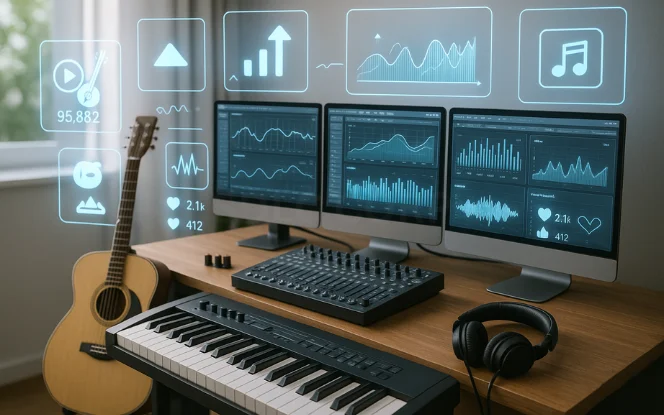
While Generative AI in music is widely recognized for composition and production, its true power lies in data-driven analytics. By combining machine learning, predictive modeling, and real-time audience insights, AI transforms creative intuition into measurable strategy, helping artists and labels align artistry with market success.
Data-Driven Musical Intelligence
Modern AI platforms don’t just generate music — they analyze massive datasets of songs, listener behavior, and market trends to inform creative decisions.
Key Capabilities Include:
- Predictive Hit Analysis → Machine learning models analyze chord progressions, tempo shifts, lyrical patterns, and vocal delivery to predict a song’s commercial potential with up to 85% accuracy.
- Real-Time Audience Feedback → AI integrates streaming metrics, social media engagement, and listener behavior patterns, creating a feedback loop that guides artists to optimize tracks while preserving artistic integrity.
- Market Trend Forecasting → By studying emerging genres and consumer demand, AI helps labels anticipate industry shifts and position artists strategically.
Personalization at Scale
Generative AI takes personalization to the next level by adapting music to audiences, contexts, and cultural nuances.
Applications Include:
- Dynamic Music Adaptation → A single track can generate multiple variations optimized for different use cases — from workout playlists to relaxation or focus-enhancement tracks.
- Cultural & Regional Customization → AI adjusts instrumentation, tonal scales, and rhythmic structures to match cultural preferences in global markets, expanding audience reach.
- Listener-Centric Experiences → Personalized soundtracks can be delivered via streaming platforms, gaming environments, and immersive AR/VR applications, boosting engagement and retention.
Specialized Expertise for Generative Music Systems
Maintaining generative AI systems in music requires expertise in audio processing, model tuning, and data governance. Some organizations choose to hire generative AI developers to manage model lifecycle activities and ensure systems adapt to evolving creative requirements.
Advisory and Governance in Music AI Systems
Generative AI in music raises questions around copyright, attribution, and ethical use. Advisory input helps define acceptable usage boundaries and compliance practices. A Generative AI consulting company may assist music organizations in aligning AI initiatives with legal and industry standards.
Conclusion
Generative AI is reshaping the music industry by enabling AI-powered composition, automated production, and personalized soundscapes. Rather than replacing human artistry, it enhances creativity and streamlines workflows through deep learning, neural synthesis, and algorithmic tools. In the coming decade, AI will be deeply integrated into music creation, mastering, distribution, and audience personalization. Musicians, producers, and labels that adopt these innovations while preserving authenticity will gain a strong competitive edge. Partnering with expert AI Development Solution providers ensures scalable, secure, and compliant solutions. The real power of AI in music lies in blending human emotion with machine precision expanding artistic expression while safeguarding music’s timeless cultural depth.
FAQs
Q1: What is generative AI music and how does it work?
Generative AI music uses deep learning (transformers/diffusion) trained on MIDI/audio corpora to model melody, harmony, rhythm, and timbre, then conditions on prompts (style, key, tempo) to create original compositions.
Q2: Who owns the copyright to AI-generated music?
It varies by jurisdiction and platform terms. Many regions require human authorship for copyright; ownership and usage often follow the tool’s ToS/license (and can differ for composition vs. master). Always review the license.
Q3: Can I use AI-generated music commercially without paying royalties?
Sometimes. Some platforms issue royalty-free or commercial licenses; others require attribution, per-track fees, or extended rights. Verify sync/streaming terms and avoid prohibited third-party samples.
Q4: Is AI music generation replacing human musicians?
No AI functions as a co-creator. It accelerates ideation, arrangement, sound design, and mastering, while humans drive artistic direction, performance, and curation in hybrid workflows.
Q5: What’s the best AI music platform for beginners?
Boomy, Soundraw, and Loudly are beginner-friendly (presets, genre templates). For more control, try AIVA (orchestral/cinematic) or LANDR for AI mastering and release tools.
Q6: How much does AI music generation cost?
From free tiers to $10–$50+/month subscriptions; pro plans can be $100–$300+/month, while enterprise is custom-priced. Many tools use credit/per-track models and separate commercial licenses.

